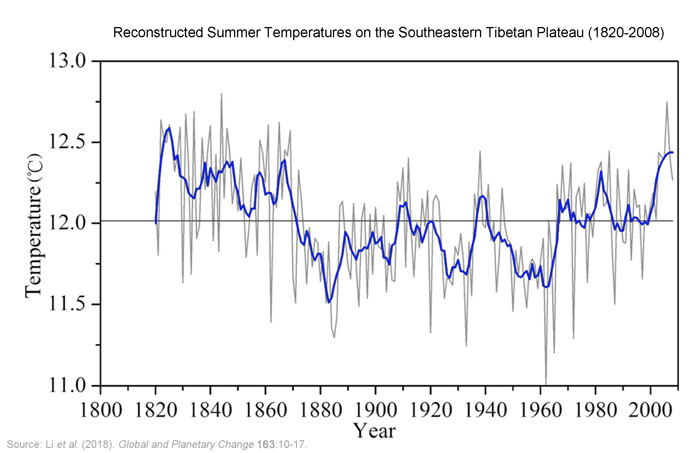| Tweet | Follow @co2science |
Paper Reviewed
Li, M., Duan, J., Wang, L. and Zhu, H. 2018. Late summer temperature reconstruction based on tree-ring density for Sygera Mountain, southeastern Tibetan Plateau. Global and Planetary Change 163: 10-17.
Introducing the reason for their study, authors Li et al. (2018) write that "exploring global or regional temperature changes with a long-term perspective is very important, as this study can improve our understanding of the status of the current warming with respect to the past several centuries, which could help us take more rational actions to address the recent climate warming." And so the team of four Chinese researchers set out to reconstruct historic summer (Aug-Sep) summer temperatures on the southeastern Tibetan Plateau.
In doing so, they cored 34 Abies georgei trees near the upper tree line of Sygera Mountain, the mean latewood density values of which were correlated with Aug-Sep mean temperatures from the instrumental era. The ensuing proxy temperature record based on that correlation is presented in Figure 1 below for the period 1820-2008. The warmest and coldest summers in the reconstruction occurred in 1844 and 1962, respectively. Following an 11-year low-pass filter on the series data, the authors discovered the existence of cold episodes prevailing during 1872-1908, 1913-1937 and 1941-1966 and warm episodes during 1821-1871 and 1970-2008. Extreme cold and warm years, defined as temperatures less or greater than the mean of the reconstructed temperatures plus/minus 1.5 standard deviations from the mean, occurred in 1962, 1965, 1933, 1972, 1885, 1920, 1884, 1862, 1886, 1950, 1955 and 1894 for cold, and in 1844, 2006, 1834, 1831, 1822, 1865, 1861, 1825, 1840, 1829, 1846 and 1869 for warm summers. Li et al. also report that multiple-taper spectral analysis applied to the reconstructed data revealed significant cycles of 2.3, 2.5, 3.5, 7.3, 35.1, 51.0 and 84.7 years, the latter three of which cycles were significantly correlated with (and likely influenced by) the Pacific Decadal Oscillation.
Considering the findings presented above, it is clear that temperatures of the past few decades on the southeastern Tibetan Plateau are not uniquely warm. Neither are they unprecedented, nor do they appear to show any influence from rising greenhouse gases over the past two centuries. If there is anything odd about the record it is the fact that only one of the twelve extremely warm years identified in the record occurred in the 20th and 21st centuries, while the remaining eleven all occurred during the 1800s!

Figure 1. Reconstructed summer (Aug-Sep) temperature on the Southeastern Tibetan Plateau for the period 1820-2008. Source: Li et al. (2018).




